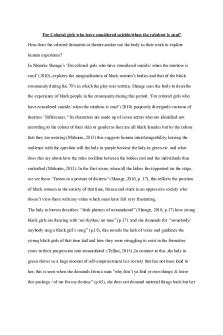NEUR3000 Discussion post 7 PDF

| Title | NEUR3000 Discussion post 7 |
|---|---|
| Author | Valerie Momplaisir |
| Course | Behavioral Genetics |
| Institution | Nova Southeastern University |
| Pages | 2 |
| File Size | 80.8 KB |
| File Type | |
| Total Downloads | 50 |
| Total Views | 140 |
Summary
Discussion Post 7 Chronic Pain, Adaptive Response....
Description
NEUR300 Discussion Post 7
1. Pain: Normal, Adaptive Response V. Chronic The normal adaptive response to pain occurs when the peripheral nociceptors are stimulated. Nociceptors can distinguish the difference between normal and chronic pain by different thresholds or the intensity of the stimulus. Dangerous stimuli usually have a high firing rate. The brain will recognize this as pain. Pain becomes chronic when there is damage to the pain pathways or a change in neural pathways. Chronic pain can be caused by the sensitization of primary nociceptors and second order neurons. 2. Anti-Inflammatory Adrenal Corticosteroids Anti-inflammatory corticosteroids are a class of drugs used to treat chronic pain. It inhibits phospholipase A-2, inhibiting the production of prostaglandin causing a decrease in inflammation. When the tissue detects damage, it releases Cox-2 prostaglandins causing inflammation. Corticosteroids block both Cox-1 and Cox-2 prostaglandins; Cox-1 prostaglandins act as house-keeping compounds that promote healthy stomach Ph, and kidney blood flow. Blocking both can cause negative side effects like peripheral edema, anxiety, hypertension, hyperglycemia, immune suppression, gastrointestinal issues, and delayed tissue repair. Cox 2 selective drugs are used to inhibit inflammation only and not the effects of the Cox 1 enzymes, the only corticosteroid that does this is Celerex, which is used to treat joint pain and arthritis. 3. "normally functioning" neuromuscular junction and myasthenia gravis. When someone has Myasthenia gravis, antibodies attack the acetylcholine receptors of the post synaptic neuron in the neuromuscular junction causing progressive muscle weakness. In a normal neuromuscular junction, an action potential opens the voltage gated calcium channels allowing calcium to enter the nerve terminal. This causes the vesicles filled with acetylcholine to open, pushing acetylcholine into the synapse of the neuromuscular junction. Next, acetylcholine binds to the acetylcholine receptors on the postsynaptic cells, causing muscles to contract. If the receptors are being attacked by antibodies, the acetylcholine cannot bind to anything.
Dabrowski, K. (2021f). Pain [Slides]. Canvas. https://nsu.instructure.com/courses/2470561/files/138730675? module_item_id=42774659
Dabrowski, K. (2021e). Neuroinflamation [Slides]. Canvas. https://nsu.instructure.com/courses/2470561/files/138730681? module_item_id=42774660...
Similar Free PDFs

NEUR3000 Discussion post 7
- 2 Pages

Discussion Post
- 2 Pages

Discussion Post
- 1 Pages

Week 3 - discussion post
- 1 Pages

Black Panther Discussion Post
- 1 Pages

Discussion Post Module 3
- 2 Pages

Module 9 - Discussion Post
- 2 Pages

Example-Discussion Post
- 3 Pages

discussion post dis
- 2 Pages

DQ 1 - Discussion post
- 1 Pages

Week 1 Discussion Post
- 1 Pages

BIO 202 Discussion Post
- 11 Pages

GLPH271 Discussion Post 5
- 2 Pages

Discussion Post 4
- 2 Pages
Popular Institutions
- Tinajero National High School - Annex
- Politeknik Caltex Riau
- Yokohama City University
- SGT University
- University of Al-Qadisiyah
- Divine Word College of Vigan
- Techniek College Rotterdam
- Universidade de Santiago
- Universiti Teknologi MARA Cawangan Johor Kampus Pasir Gudang
- Poltekkes Kemenkes Yogyakarta
- Baguio City National High School
- Colegio san marcos
- preparatoria uno
- Centro de Bachillerato Tecnológico Industrial y de Servicios No. 107
- Dalian Maritime University
- Quang Trung Secondary School
- Colegio Tecnológico en Informática
- Corporación Regional de Educación Superior
- Grupo CEDVA
- Dar Al Uloom University
- Centro de Estudios Preuniversitarios de la Universidad Nacional de Ingeniería
- 上智大学
- Aakash International School, Nuna Majara
- San Felipe Neri Catholic School
- Kang Chiao International School - New Taipei City
- Misamis Occidental National High School
- Institución Educativa Escuela Normal Juan Ladrilleros
- Kolehiyo ng Pantukan
- Batanes State College
- Instituto Continental
- Sekolah Menengah Kejuruan Kesehatan Kaltara (Tarakan)
- Colegio de La Inmaculada Concepcion - Cebu

